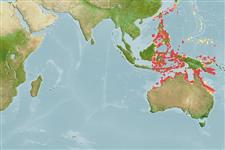>
Gobiiformes (Gobies) >
Gobiidae (Gobies) > Gobiinae
Etymology: Eviota: No etymology given, suggested by Christopher Scharpt: from Latin 'eu' for 'true' and 'iota' for anything very small, in combination 'truly very small' referring to it as being the smallest vertebrate at the time it has benn described by Jenkins (thus, making the suggestion by Scharpt plausible; atriventris: The specific epithet is an adjective combining the Latin atrus (black) and venter (belly), referring to the black pigment in the area of the abdomen (Ref. 89418).
More on authors: Greenfield & Suzuki.
Environment: milieu / climate zone / depth range / distribution range
экология
морской ассоциированный с рифами; пределы глубины 3 - 20 m (Ref. 90102). Tropical; 31°N - 24°S, 116°E - 154°E
Pacific Ocean: Japan (southern Ryukyu Islands), Thailand, Brunei, Malaysia, Philippines, Palau, Indonesia (NW Kalimantan and Bali eastwards), Papua New Guinea, Solomon Islands, south to Australia (Great Barrier Reef) and east to New Caledonia.
Size / Вес / Возраст
Maturity: Lm ? range ? - ? cm
Max length : 1.7 cm SL самец/пол неопределен; (Ref. 89418)
Краткое описание
определительные ключи | морфология | морфометрия
колючие лучи спинного плавника (общее число) : 7; членистые (мягкие) лучи спинного плавника (общее число) : 8 - 9; колючие лучи анального плавника: 1; членистые (мягкие) лучи анального плавника: 7 - 8. This species is distinguished from its congeners by the following set of characters: abdomen with black peritoneum, clearly visible externally; dorsal/anal formula 8/7; simple pectoral-fin rays; length of 5th pelvic-fin ray 40% or greater of 4th ray; genital papilla in male not fimbriate; cephalic sensory-pore system pattern group 2 (only IT missing) (Ref. 89418); characterized further by translucent red with pair of bright yellow stripe behind eye, lower stripe reaching midbody and upper nearly to caudal fin base; fins unmarked; longitudinal scale series 23-24; ctenoid scales, absent on head, nape and pectoral fin base; separated pelvic fins, thin membrane joining bases; 3-5 branches on fourth pelvic ray; depth of body 3.6-4.0 in SL (Ref. 90102).
Lives in small groups near Acropora colonies where it hides when threatened. Feeds on plankton(Ref. 89963). Sometimes solitary, frequently in shady spots near corals (Ref 90102).
Life cycle and mating behavior
половая зрелость | размножение | нерест | икра | Fecundity | личинки
Greenfield, D.W. and T. Suzuki, 2012. Eviota atriventris, a New Goby Previously Misidentified as Eviota pellucida Larson (Teleostei: Gobiidae). Zootaxa 3197:55-62. (Ref. 89418)
Статус Красного Списка МСОП (Ref. 130435: Version 2024-1)
Угроза для людей
Harmless
Использование человеком
дополнительная информация
инструменты
Специальные отчеты
Скачать в формате XML
ресурсы в Интернет
Estimates based on models
Preferred temperature (Ref.
123201): 27.8 - 29.3, mean 28.7 °C (based on 946 cells).
Phylogenetic diversity index (Ref.
82804): PD
50 = 0.5000 [Uniqueness, from 0.5 = low to 2.0 = high].
Bayesian length-weight: a=0.00692 (0.00284 - 0.01683), b=3.10 (2.92 - 3.28), in cm total length, based on LWR estimates for this Genus-body shape (Ref.
93245).
Trophic level (Ref.
69278): 3.0 ±0.3 se; based on size and trophs of closest relatives
Fishing Vulnerability (Ref.
59153): Low vulnerability (10 of 100).
Nutrients (Ref.
124155): Calcium = 585 [228, 2,435] mg/100g; Iron = 2.18 [0.79, 5.51] mg/100g; Protein = 17.4 [15.2, 19.5] %; Omega3 = 0.101 [0.026, 0.413] g/100g; Selenium = 42.2 [8.7, 166.6] μg/100g; VitaminA = 93.4 [13.2, 625.6] μg/100g; Zinc = 6.42 [2.99, 11.85] mg/100g (wet weight);
